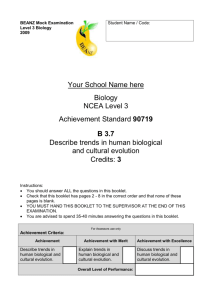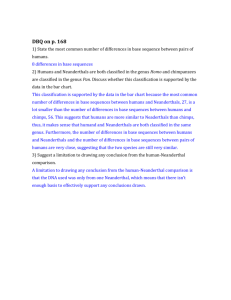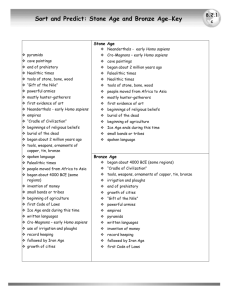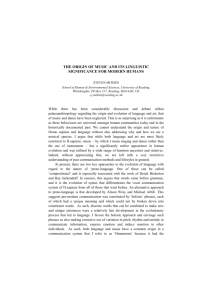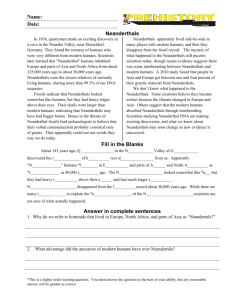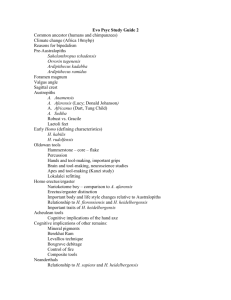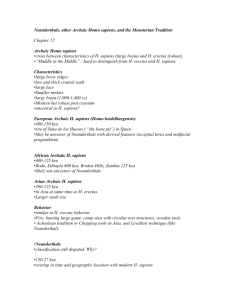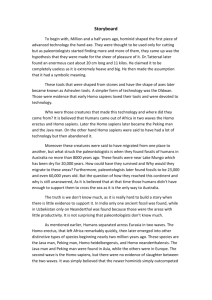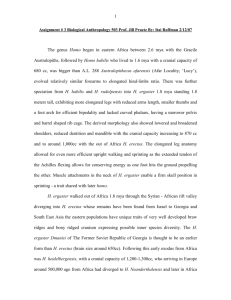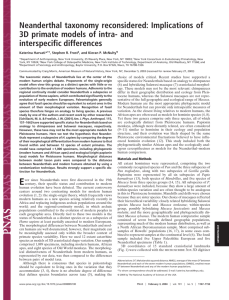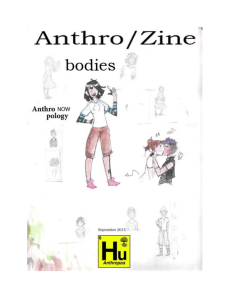Becoming Human – Hour 3
advertisement
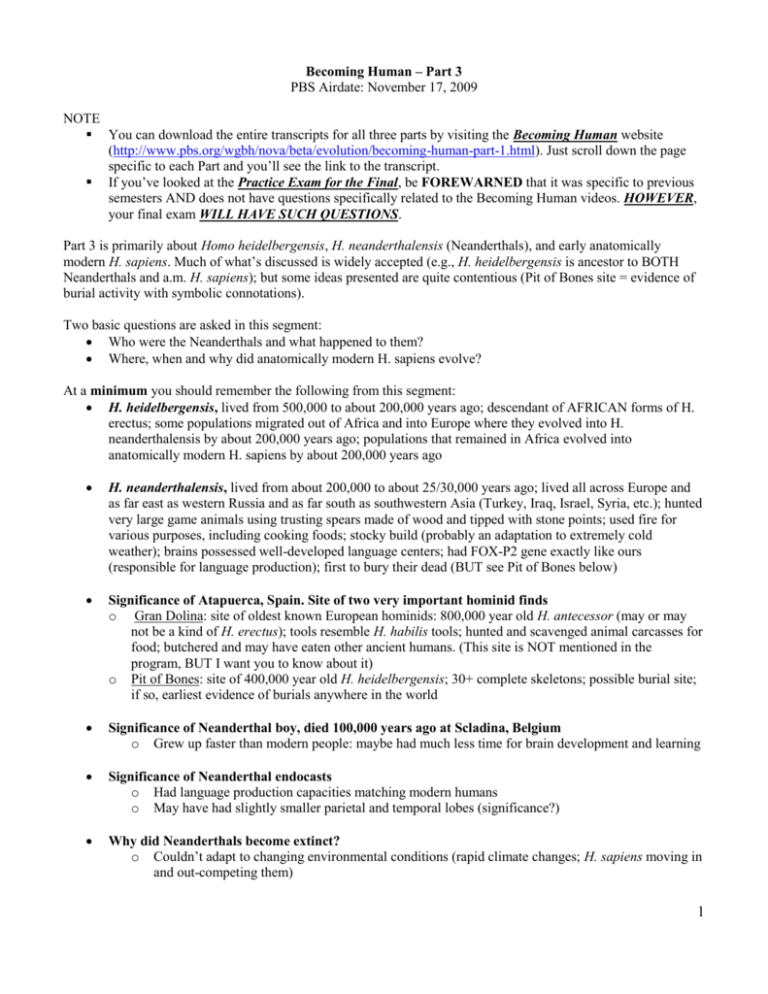
Becoming Human – Part 3 PBS Airdate: November 17, 2009 NOTE You can download the entire transcripts for all three parts by visiting the Becoming Human website (http://www.pbs.org/wgbh/nova/beta/evolution/becoming-human-part-1.html). Just scroll down the page specific to each Part and you’ll see the link to the transcript. If you’ve looked at the Practice Exam for the Final, be FOREWARNED that it was specific to previous semesters AND does not have questions specifically related to the Becoming Human videos. HOWEVER, your final exam WILL HAVE SUCH QUESTIONS. Part 3 is primarily about Homo heidelbergensis, H. neanderthalensis (Neanderthals), and early anatomically modern H. sapiens. Much of what’s discussed is widely accepted (e.g., H. heidelbergensis is ancestor to BOTH Neanderthals and a.m. H. sapiens); but some ideas presented are quite contentious (Pit of Bones site = evidence of burial activity with symbolic connotations). Two basic questions are asked in this segment: Who were the Neanderthals and what happened to them? Where, when and why did anatomically modern H. sapiens evolve? At a minimum you should remember the following from this segment: H. heidelbergensis, lived from 500,000 to about 200,000 years ago; descendant of AFRICAN forms of H. erectus; some populations migrated out of Africa and into Europe where they evolved into H. neanderthalensis by about 200,000 years ago; populations that remained in Africa evolved into anatomically modern H. sapiens by about 200,000 years ago H. neanderthalensis, lived from about 200,000 to about 25/30,000 years ago; lived all across Europe and as far east as western Russia and as far south as southwestern Asia (Turkey, Iraq, Israel, Syria, etc.); hunted very large game animals using trusting spears made of wood and tipped with stone points; used fire for various purposes, including cooking foods; stocky build (probably an adaptation to extremely cold weather); brains possessed well-developed language centers; had FOX-P2 gene exactly like ours (responsible for language production); first to bury their dead (BUT see Pit of Bones below) Significance of Atapuerca, Spain. Site of two very important hominid finds o Gran Dolina: site of oldest known European hominids: 800,000 year old H. antecessor (may or may not be a kind of H. erectus); tools resemble H. habilis tools; hunted and scavenged animal carcasses for food; butchered and may have eaten other ancient humans. (This site is NOT mentioned in the program, BUT I want you to know about it) o Pit of Bones: site of 400,000 year old H. heidelbergensis; 30+ complete skeletons; possible burial site; if so, earliest evidence of burials anywhere in the world Significance of Neanderthal boy, died 100,000 years ago at Scladina, Belgium o Grew up faster than modern people: maybe had much less time for brain development and learning Significance of Neanderthal endocasts o Had language production capacities matching modern humans o May have had slightly smaller parietal and temporal lobes (significance?) Why did Neanderthals become extinct? o Couldn’t adapt to changing environmental conditions (rapid climate changes; H. sapiens moving in and out-competing them) 1 Origins and evolution of anatomically modern H. sapiens o Descendants of African H. heidelbergensis o First appear about 200,000 years ago in Africa o Mega-drought at 140,000 years ago = dramatically altered African environment (produced vast uninhabitable areas); H. sapiens experienced bottle-neck event = population reduced to about 600 breeding individuals: teetered on brink of extinction Remnant populations took refuge mainly along south African coasts Began to exploit new resources, principally shellfish, penguins, also hunting/gathering on coastal plains (reflects a new versatility). o Pinnacle Point, South Africa: spans 140,000 to 70,000 years ago (see Klasies River Caves info below) Some of earliest evidence that H. sapiens living off sea (cooked shellfish) = 70,000 years ago Earliest tools (140,000) made from beach cobbles; later tools (70,000 years ago) made from very different stone = heated in fireplace to produce better flaking qualities o First clear evidence of use of symbols (earliest at Blombos, South Africa 75,000 years ago) Piece of red ocher (type of soft rock) with cross-hatched patterns etched on it; marine shells w/ holes drilled in them (beads?) o Between 100,000 – 60,000 Produce new technologies, new cultures Start streaming out of Africa / encounter remnants of earlier migrants (e.g., H. erectus in southeast Asia and Java; H. floresiensis in Java; Neanderthals in Europe) What happened as moderns encountered Neanderthals? o Inter-species warfare: no evidence o Interbreeding: no Neanderthal DNA in modern populations o Moderns more efficient at exploiting environment: some evidence (new types of hunting tools, esp. the throwing spears vs. the thrusting spear of Neanderthals) o Moderns had higher birth rate, babies had higher probability of surviving: speculative o Neanderthals unable to quickly adapt to wild climate swings happening in Europe around 40,000 – 25,000 years ago: speculative o Neanderthals unable to meet their energy needs (5,000 calories / day vs 2,200 for moderns): very speculative, especially since they’d survived for over 150,000 years with those same energy needs Klasies River Caves (This was NOT in Part 3 – but I want you to know it as it adds to the Pinnacle Point data) o Southeast coast of South Africa o 130,000 and 60,000 years ago o People ate shellfish, antelope, seals, penguins, and plant foods, roasting them in hearths built for the purpose: shows systematic use of marine resources at very early date (118–130,000 years ago) o Earliest levels of site: stone tools / flakes made from locally available beach cobbles; later tools made from material located 20 kilometers away o Fire-blackened fragments of human skulls / other bones showing cut marks = mixed with rubble of kitchen debris – thrown out with shells / bones of the remainder of the meal = cannibalism? 2
